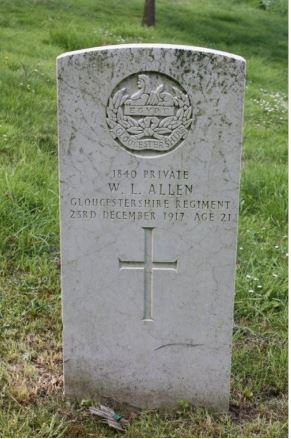1st Battalion, Gloucestershire Regiment

William Leonard Allen was the fourth of eight children born to Henry and Mizellia (formerly Loveridge) Allen — a gypsy family. His Mother’s name is variously spelt amongst historical records including Millicent, Priscilla and Ella.
William’s birth was registered at Highworth, Swindon in the third quarter of 1894 and there is a baptism record for William dated 9 August 1894. His parents’ names being given as Henry, a labourer, and Priscilla.
At the 1891 Census the family were living at Rockness Hill, Horsley. Henry, 24, states he was born in Nailsworth and Mizellia, 25 in Shipton’s Lane, Wiltshire. They had two sons Gilbert and Andrew born in Kingscourt and Feltham, Middlesex respectively.
William next appears in the prison records at Gloucester in March 1910. Together with his brother Andrew, William was charged with stealing sheepskins from Tetbury. His age was given as 16 and his height only 4’11½”. The pair were found guilty and sentenced to seven days.
The 1911 Census shows the family living in Woodchester, Henry was a licensed hawker and Mizellia gave her occupation as ‘assistant’. William is not with them but there are three more children, the youngest two having been born in Farnham, Hampshire. The couple said they had been married for 24 years but this appears not to be the case. There is a marriage register entry for Henry Allen and Mizellia Loveridge in 1932. The family tree on Ancestry states they were first cousins. They also state they had seven children not eight. Two of the children George and Harold both have a birth date of 1899. I have been unable categorically to find William listed on the 1911 Census.
Thankfully, comprehensive service records survive including the medical board reports. William attested at Stroud into the Special Reserve and joined the 3rd Battalion, Gloucestershire Regiment for a period of six years on 2 February 1913, aged just over 18. He was deemed fit for service. He was only 5’ 2¼” tall.
William was in training until 11 November 1914, when he was sent to France with the 1st Battalion of the Glosters, to join the British Expeditionary Force. He received a gunshot wound to the right thigh on 22 December 1914, returning home on the hospital ship Carisbrooke Castle on Christmas Day. He was home until 9 February 1915. He returned to France on the 10th and was there until 30 April 1915. He returned to England on 1 May 1915. Details of next of kin were recorded as Mother — Mrs K Allen, 1 Down Cottage, Upper Crown Street, Reading and Father — Henry Allen, Boon Hill Farm, Woodchester, brothers Andrew living in Nailsworth, Gilbert in Trowbridge and Wilfred — address unknown.
On 19 June 1916, William was discharged having been ‘found no longer physically fit for war service’. He had served for three years and 138 days. His military character was said to be ‘very good’ and he was a ‘steady sober man’.
However medical reports show that William was suffering from mental illness. The report of the Medical Board on 29 April 1916 stated that William was medically unfit – mental deficiency. The origin was deemed to be congenital.
The report states: At Netley: Cannot give account of himself. Cannot read or write. Education has been of the lowest order. His manners and appearance suggest imbecility, not caused by military service. Not stated whether aggravated. Permanent total incapacity. Expires 19th December 1917.
William was admitted to Dykebar War Hospital, Paisley on 3 February 1916. This was the regional asylum taken over by the military. Captain R G Bannerman wrote the following report under the title Medical Report of an Invalid: Mental deficiency congenital origin. Service in France 3 months. 1st May 1915: At Netley. Cannot give account of himself. Cannot read or write. Does not now how long he has been here, nor where he is.
10th May 1915: Marked emotional indifference. Defective perception of time and place.
3rd February 1916: Admitted to this hospital. Showing above features. Such history as he gives shows that his education has been of the lowest order. His manner of appearance suggest imbecility. He smiles foolishly and takes no interest in his mates or surroundings. He is foolish, disorientated and cannot read or write. Discharged as permanently unfit.
Medical Board 6th September 1917: “Letter from Dr Cartwright dated 3rd September 1917 states man is at present in Wiltshire County Asylum in Devizes. Aggravated by service since the declaration of war. Presents 100%. A doubtful case. Was evidently always of a low intellectual standard but apparently able to do his duty. 20/- from 26th June 1916 to 3rd April 1917 then 27/6 during detention in asylum in lieu of original award.
William died in the County Asylum Gloucester on 23 December 1917: according to the burial register, and was buried on the 29th at St Mary Magdalene Church at Rodborough. He has a CWGC headstone.
There is an entry in the Register of Soldiers’ Effects. It states that he was ‘discharged insane’. Henry received a payment of £8 10s. Payment was made to five others including 12 shillings to Goodwins the undertakers, ‘The Station Master’ 12 shillings plus £16 10s to the Clerk to the Guardians.
There are several entries in the Pension Ledgers for both William and his brother George who was an acting Corporal with the 8th Battalion, Gloucestershire Regiment when he was killed in action on 20 October 1918. He has no known grave and is remembered on the Vis-en-Artois Memorial. The CWGC lists his parents living at Reading.
There is a pen portrait of William on the web site of Remembering Rodborough. It states that he was born in Rodborough (which I believe is incorrect). He attended Kingscourt School and was from a traveller family. He enlisted in 1913 and was wounded in France in 1914. By 1915 he was no
longer fit for service and was discharged. He died on 23 December 1917 at 05:45 aged 21 of TB whilst an inmate of Wootton asylum suffering from shell shock. His brother George was killed in action and is remembered in the church. (This is the only reference to shell shock that I have come across in my research so may well be a conjecture).
Records for William’s short time at Wootton asylum are held at Gloucestershire Archives. The Admission Register Book (ref HO22/63/20) shows that Private William Leonard Allen (1840) was admitted from Devizes Asylum on 20 October 1917. The original reception order was dated 20 May 1916. The authorisation was by F G Gilpin, Brigadier General for the GOC Scottish Command. Admission papers themselves are held under reference HO22/83/3/41. They contain Army Form B 263 – ‘Order for the Reception of a Dangerous Lunatic Soldier’. However, there is nothing in the papers to suggest William was dangerous. The Medical Superintendent writes: ‘ … congenital imbecility. Is dull and lost in appearance and answers questions briefly and reluctantly. Takes no interest in anything and is wet and dirty in his habits. He is in poor health and the subject of pulmonary tuberculosis’. There is a letter from the Medical Superintendent of Devizes to his opposite number in Gloucester stating that William’s Mother, Mrs E Allen of Pen Lane, King’s Stanley, was keen that her son be moved to Gloucester so that friends can visit. The comment from the Superintendent was that he knew of no other friends or relatives except the Mother.
Notes made on admission include: ‘ … although described as a congenital imbecile the army discharge shows patient served nearly 2 years in the colours and was wounded in the right thigh.
I cannot identify the site of the wound. Has ulcerated left thigh. Old scar on right knee. Figure of girl tattooed on right forearm. Dysentery April 1917. Is dull and stupid and at times obstinate. c cardiac signs rapid. Some signs of phthisis at right apex (TB). Enlarged gland in right submaxillary region (saliva glands)’.
There is a short record for William in the Case Book (male) held at Gloucestershire Archives (page 281) under reference HO22/70/30 covering his time at Wootton Asylum.
The cause of admission was given as ‘congenital since birth’ and as to whether he was a danger to others, ‘impulsive at times’ was recorded. An entry dated 18 May 1916 gave the report from W Buchanan of Dykebar War Hospital: ‘His appearance and manner are those of a low-grade imbecile. His ideas and associations are infantile and he cannot read or write. His conduct and talk are foolish and he is unable to take care of himself’.
History: He is a small fellow (complex?) young man. Hair dark, eyes brown, pupils equal and active. Cardiac sounds rapid and easily audible all over the chest. There are some signs of phthisis at the apex of the right lung. Abdominal organs normal. Old scar on right knee. Figure of girl tattooed on left forearm. Sign of ulcer on left thigh. Enlarged gland in right sum maxillary gland.
Mentally: A congenital imbecile. Dull and lost in appearance and will hardly walk at all. Lies in bed taking no interest in his surroundings and is wet and dirty in his habits.
There are only five dated entries for William’s time at the asylum. There is no indication that he was treated for his mental condition, his physical health deteriorating rapidly.
27 October: Wet and dirty daily. Appears weak in his
bed.
3 November: No change. Seldom speaks and is wet
and dirty every day.
10 November: Says a few words only. Weak
physically.
17 November: Continues very weak but answers
simple questions more willingly.
23 December: Died at 5:45am.
Cause of death Pulmonary Tuberculosis.
The fact that William was able to serve with the army in the early years of the war and was said in June 1916 to have had a very good military character and have been a ‘steady sober man’, suggests that something happened to affect him mentally. Great emphasis was placed on congenital imbecility but this was apparently not evident when he joined the Army in 1913 when he was passed as fit.
I understand that shell shock was recognised early on in the war but by 1917 the term was banned as a diagnosis in the British Army with mentions of it censored even in medical journals.
Researched by Helen Wollington April 2021
